
 |
|
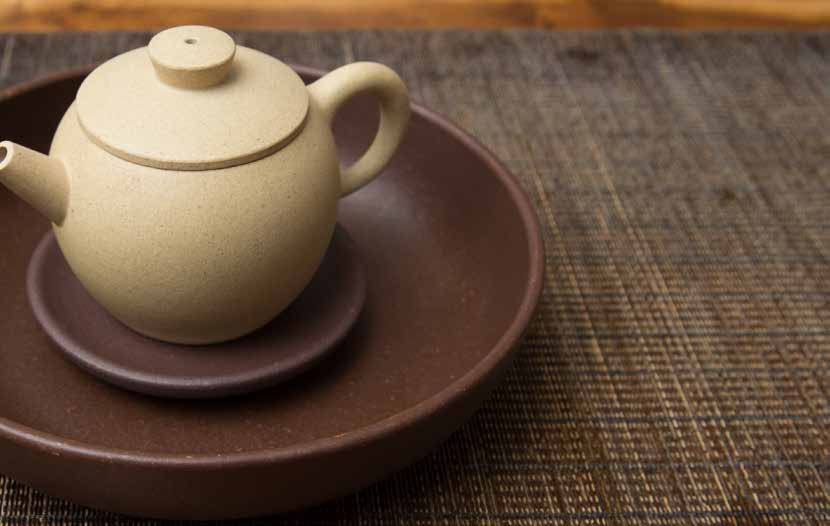
Months before flying to Yixing, I knew it was going to be one of the most important trips I'd ever take. This wasn't the ordinary tourist stint, poking my head into ceramicists' workshops, sniffing through shelves of pots and sculptures in the market or taking photos with friendly locals. At the station waiting for me, down a long and drab corridor, was my own master Lin Ping Xiang, a dear brother and mentor Henry Yiow and Master Zhou Qi Kun. Master Zhou is one of the best teaware makers alive, and certainly my favorite person in Yixing! I was being welcomed by the best possible guides one could ask for: My master has decades of experience studying Yixing teaware and traveling there, and so does Henry, and Master Zhou is one of the most knowledgeable experts on Yixing history, art and production in the world. And so the hugs at the end of that corridor were the culmination of a long-standing dream - one that I'd spent months preparing for, emptying myself in a 17 readiness to absorb and learn all that I could about my favorite teapots. Yixing pots have taught me so much, and are some of my oldest and most precious friends and teachers on my journey. So before I left Taiwan, I held an old pot and smiled, imagining the trip to come...
Two weeks is a long time to spend in the small town of Yixing, but I was no ordinary tourist. Sure, there's not a lot to see by way of attraction, and most people can learn what they need to about teapots from just a few days. But I wanted a deep immersion, especially given the opportunity to do so at a time in my life when my Chinese has reached a decent fluency and I would be surrounded by such amazing wisdom in the form of the generation of tea brothers above me. I also had a second, more heartfelt reason for going: to bond with a dear brother and friend.
It always takes a while to get used to the overwhelming kindness and hospitality of a Chinese friend. Master Zhou and I had spent time together in Wuyi and at tea events, always joking back and forth that the flight to or from Taiwan is so short: "Why haven't you visited?" and then lovingly, "No, why haven't you visited?" And so, this trip was a great opportunity to get to know him, his family and to see the way he lives. We had three days with my master and Henry, followed by around ten days together alone. They surrounded me with delicious vegetarian food, great tea, put me up in a nice hotel and made sure I wanted for nothing. When I look back on how much love Master Zhou and his family showered on me, making me feel at home and taking me around to learn about the history and production of traditional Yixing crafts, my eyes moisten with nostalgia and love. Such generosity is rarely met with in this world, and worthy of a deep bow.
I tried to go there without a notebook - without any plan or pre-determined idea about what I could or should learn. I knew there were some gaps in my knowledge, but I didn't want to approach the trip as if I were some kind of expert with a solid understanding of Yixing that only needed patching up here or there. Rather, I wanted to show up with a beginner's mind: knowing nothing, receptive and ready to be guided to the lessons I need, and ready to renew my contract with things I think I know. My cup was empty, in other words. And over hundreds of cups of strong "Yixing Gongfu Red Tea", the lessons started unfolding each day...
Master Zhou was the best teacher I could hope for. He genuinely loves tea and teapots. With true tea spirit, his eyes beamed with glee whenever I'd ask him about anything that came up. He'd immediately dive into the topic with enthusiasm, talking slowly when necessary, or repeating himself, to make sure I understood. Like any good teacher, he also knows that real understanding can't be just intellectual. We would talk and drink tea at his house - me asking questions and him answering in greater depth than I could have possibly imagined over cups of tea. Then as we talked about clay, for example, at some point in the teaching, he would put his cup down and smile at me, emphatically grabbing his keys: "Let's go!" And off we'd go to one of his many, many friends' or students' places to see whatever we'd been discussing in person and get our hands into the matter.
In going around to hundreds of the pottery studios of Master Zhou's students, ore collectors, clay makers, kiln workers, wood-fired kiln workers, teapot collectors/vendors, etc., it became very clear to me that all the loving-kindness that Master Zhou was showing me day after day wasn't for me alone. Everywhere we went, eyes lit up and people expressed honor at the visit. I could tell that the deep and vast knowledge he was sharing with me wasn't coming from a dammed up and protected reservoir, but rather a flowing river of Tea wisdom that he shares with passion and love to anyone who asks. I saw the respect, gratitude and love I felt for him mirrored in every one of the people we visited.
Long before I went to Yixing, I knew that I would write an article like this, sharing some of what I learned with all of you. As a result, you all traveled there with me. You were in my heart, and even discussed at length with Master Zhou, who now understands more of what our community is about. He expressed a pride to be involved.
In the end, I felt like I successfully deepened a lifelong friendship and bond with Master Zhou and his family and also made some new friends as well. Beyond that, I learned more than I could ever type in a few hours (more than just filling in the gaps of my understanding of Yixing, I feel a bit more experienced). Despite finding my cup so very full by the end of the trip, the encounter with Master Zhou's endless treasury of knowledge, both information and experience, definitely left me feeling like there are lifetimes more to learn when it comes to Yixing teaware and Tea in general! But we have to start somewhere, so why not here. I thought I would share with you some of the things I learned on my trip as well as some of the experiential highlights, thereby fulfilling my earnest desire to take you all with me in spirit...
Like anything in this modern world, you can find all the conditions for a positive or negative experience within the experience itself - dependent on your orientation. I usually take a balanced approach, exploring the truth in both the problems/challenges and the active, as well as potential solutions. That is Zen.
As we've discussed in the article introducing Yixing, it is a magical ore found only in Yixing. It's marriage to Tea dates back five hundred years. At the beginning of the Ming Dynasty, the empire was financially destitute. The first Ming emperor came from a humble background, and was therefore committed to economic reform. At the time, it was popular to drink powdered tea, which required a greater investment of labor for a lower yield. Therefore, the emperor outlawed such tea, and inspired people to return to steeping their tea.
In those days, pottery towns were called "kilns" since wood firing is very labor-intensive and also expensive. This meant that ceramics were not fired by individual potters, like today, but rather as a village - in large kilns that were operated by kiln masters. With the new style of brewing, the kilns of course began making new kinds of teaware to sell to tea lovers around the empire. The amazing thing is that in a very short time, most the other kilns went back to making what they had before: a balance of plates, bowls, vases and some teaware. One city, on the other hand, very quickly got busy making teapots. And when I say busy, I mean every man, woman and child in the town were somehow involved in mining the ore, refining the clay, making pots or selling them! Artists from far afield also moved there to help carve calligraphy or designs into teapots, paint on them with glaze, etc. That town was Yixing, the teapot capital of the world.
There are many reasons for Yixing teapots' success. While the aesthetics of purple-sand teaware may be on that list, it is nowhere near the top. Most Chajin definitely gravitate towards simplicity in their tea journey, and the subtle decorations of Yixing ware very much suit a wabi tea spirit. But many people gravitate towards more elegant and refined teaware. Of course, Yixing masters can also make refined and decorative ware, but it's doubtful that their skills would really set the town apart from say porcelain teaware from Jing De Zhen, which can be painted with glazes of so many colors and refined to its own great elegance. Purple-sand teaware has great aesthetic value, but that is not what married it to Tea, nor the reason why it eclipsed all other kilns in the production of teapots for tea lovers throughout the empire and eventually beyond in export to other countries. For that we have to turn to the ore.
There is a magic relationship between the ore from Yellow Dragon Mountain and its surroundings that changes the nature of tea liquor. This is incredibly obvious to almost anyone, no matter how far they have progressed in their tea journey. If you but take three grams of a tea you are familiar with and put it into a purple-sand teapot alongside another clay, like porcelain, the difference is obvious - especially in the mouthfeel and Qi. As Chajin progress in learning and mastering gongfu tea, we usually move more and more towards drinking structure, as opposed to flavor and aroma. The structure of tea influences its integration into our bodies and then subtle bodies (Qi) much more, and is therefore of growing concern to a tea lover over time. And on the level of structure, the influence of real Zisha (purple-sand) is magical and awe-some! It makes the tea smoother, more rounded and "real". Even the flavors and aromas distill and become subtler, rounded and more long-lasting - getting Tea to release its essence slowly, subtly and smoothly over many more steepings is at the core of what gongfu tea is all about. No words can substitute for experiencing the effects Yixing ore/clay has on water/tea liquor. There is a sign when you come to Yellow Dragon Mountain that reads: "There's only one ceramic teapot in the world and her name is Yixing."
All good teaware is completely or at least in part "stoneware", which we define here as clay that is produced from ore mined in the earth, as opposed to river/lake clay. Traditionally, the ore in Yixing was mined from deep in the earth, where it has slowly formed over hundreds of millions of years. It is then weathered outside, which also activates organics and therefore fermentation. The rain and wind break the ore down into pebbles. These pebbles are then stone-ground into a powder, which is mixed with good spring water to make clay. The clay is then pounded and shaped into bricks. These bricks are then further aged. Like puerh, the older the better. They are full of microbes and actively ferment. We have some bricks of nice, old Zisha clay aging in our center for future pots!
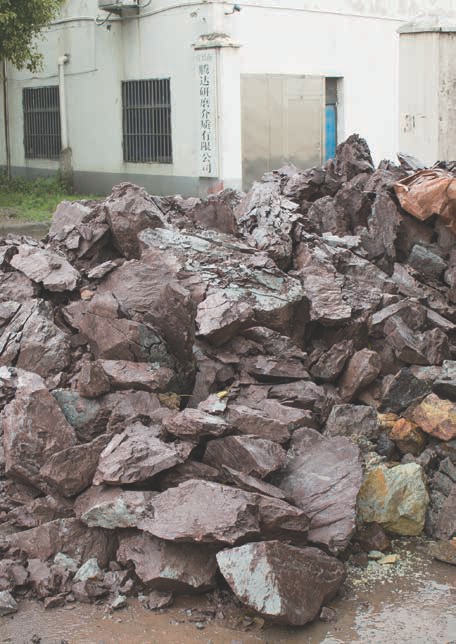

The problem/challenge is that the mines in Yixing have been closed, and for good reason. Voracious demand and unscrupulous, unregulated business in China had the potential to cause drastic envi ronmental issues. Almost all mining had run down to a trickle by the 1990's, and then stopped complete in the early 2000's. The bad news is that most of the pottery coming from Yixing nowadays is not made from local ore, but rather ore imported from outside - almost all from Gong De and other places in Anhui province. This ore lacks many of the qualities that married Yixing teapots to Tea. In fact, it bears little resemblance to the energy/structure of real Yixing ore/clay/teapots, and really only matches in appearance (to the untrained eye; Master Zhou and Master Lin can of course tell the difference). There are shared mineral content between them (hence the similar appearance), and others are added later; but that is obviously not the same as what Nature herself created over hundreds of millions of years! As it turns out, ore for teapots, like tea, has a terroir all its own.
It is certain that like food, Tea or any other industry in the world, the cheaper products suffer most from inauthenticity. This is the first time in history, for example, that poor people are often more obese/ unhealthy than rich people, as the cheaper foods contain the most chemicals and are the most nutrient deficient. Similarly, the greater mass of Yixing goods, from teapots to "tea critters (cha chong, 茶寵)" are all made from inauthentic ore.
The secondary challenge that results from this is that tea lovers aren't as certain of the magic of purple-sand, the way they were in the Ming and Qing dynasties. Nowadays, people experiment with an Yixing pot and find little to no difference from other clays. Some even say that their pot seemingly produces lower quality tea. Such experimentation can be complicated by the fact that there are many kinds of authentic Yixing ore, organized into the categories we discussed in our introductory article. But the real reason that most tea lovers don't notice a positive influence, or even find a negative one, is that the pot they are using is not made from authentic Yellow Dragon Mountain or other local ores. This, of course, complicates the tea world/market and extends the learning curve for us all...
After the bad news, there is the good news: When the government factories closed in the 1980's they had tons (literally) of ore breaking down outside and tons (again, literally) of clay fermenting inside. It was distributed amongst the employees based on time of service and seniority. Consequently, there is quite a bit of real clay around, and many of it is good and old. While there is not much English literature on authentic ore yet, there are some great Chinese resources. If you come to the center, we can show you some great books (full of pictures), as well as some old shards and pieces of ore so you can begin to resonate with the energy of this most magical rock. And as a glimpse of some real magic to come in 2015, we are very close to releasing a magical way for you to support the building of our new center, Light Meets Life, and get a hold of some authentic Zisha teaware in doing so! More on that soon...
One of the many reasons Master Zhou commands such a powerful understanding of Yixing tea art is that he has access to a large supply of gorgeous clay that was passed down to him from his father. His relationship to that real clay over decades helped him cultivate a deeper and more refined relationship to the tradition of Yixing teapots that dates back five hundred years. He's not the only one, but the spirit that relationship awoke in him makes him very unique indeed. And that is the second topic I'd like to explore...
My master told me that when he first started collecting Yixing pots and going there many decades ago, he was very confused about something: The ore has been in the Earth for hundreds of millions of years, so why would a hundred years matter at all in terms of teapots? Through years of practice brewing gongfu, he knew that the pots from the Qing Dynasty made magical tea. Of course, this had to be the clay. But a hundred years seems but a blink in the life of something so old. Was it the processing of the clay? The teapot art?
At a gathering, he finally got to ask some masters this question. At first, he thought that they didn't even answer his question, but after he got home and thought about it more, he realized they had. He asked them why Qing pots are better, since the ore is so old. One of the masters said that he was wrong, continuing: "In those days they had rudimentary handmade tools, mostly made of bamboo. We have precision instruments of many kinds. And they didn't understand so much of the chemistry and make-up of the clay. We have a detailed and thorough knowledge of this, so we can combine colors and clays in new and unique ways. Long ago, they had to wood-fire everything, which isn't very precise. With electric kilns, we can control temperature to a degree." Then he raised his voice in triumphant conclusion, "In those days they just made teapots. We make works of art!"

You can see why my teacher was a bit confused at first. Later, he realized that they had in fact answered his question: they don't make teapots. Of course what they make is worse for tea, because they don't see it as a teapot. Ultimately, this story is a bit cartoonish and over-simplifies a point. Also, there is nothing wrong with being an artist. Paintings are less functional than teapots made as objects of art, but I still paint. Art has its own function. Yixing is a marvelous art form. The pieces that masters create are profound and gorgeous. Even a mold-made pot can take one to three days to complete, and is no trifle. There is a lot of skill and beauty in Yixing pots, and to many people they are worth collecting. However, they started out functionally. They started out as teapots. That is their origin and heritage. No one would argue that there is a middle ground - where form and function meet. In that space, the best pots are made. Pots that both make wonderful tea and are also gorgeous. Most seasoned tea lovers, however, know that carvings, designs and elegant shapes rarely make the best tea. The best pots for brewing are always simple, in other words.
In traveling around to dozens and dozens of shops and artists' workshops, I quickly realized that there are tons of artists and no teapot makers anymore. With the economic boom in China, master potters have all moved into mansions. Their pots are worth a fortune, and unless you are rich enough to not care, spending so much money makes it hard to use them for tea every day. What was simple is now pretentious. And the fear of breaking such an expensive treasure seems to limit their use.
As financial success has become a real possibility for unique artists, master potters have slowly lost the skill and knowledge of pairing this magical ore/clay with Tea. They have started choosing colors based on design and appearance, almost always adding chemicals to the original clay to make brighter greens, blues, reds, etc. While many of them drink tea, it is usually very casually, always Yixing red tea and always beneath many cigarettes. And without the guidance of customers like Master Lin to steer them towards better clay for tea, Yixing teaware has polarized into two main varieties: 1) cheap, mass-produced goods which represent most of the actual Yixing teapots for brewing tea that are used in the world; and 2) masterpieces that are meant to highlight design skill and/or innovation and are sold for very high prices to art collectors who may or may not use them to brew tea. In the end, the proof is in the trip: I explored all the markets thoroughly and met tons of potters, and did so with a very open mind, and I didn't see a single pot that I would use for tea brewing that the center could afford!
The good news is that Master Zhou and Master Lin have been working together for more than a decade to create new kinds of clay that make great tea! Master Lin has brought many Qing and Ming pots to Yixing so that he and Master Zhou can explore the relationship of the clay to Tea. Master Zhou also knows where to find Qing and Ming shards, which was one of the great highlights of my trip. We spent an hour or so hunting through the ground for old teapot shards, and finding several. Master Lin can feel them, and I was able to successfully feel a buried half of a lid from a Ming pot that even had the button intact! It was a happy moment, indeed... Anyway, with these pots and shards and Master Zhou's knowledge of Yixing history, they have been hard at work experimenting with ore/clay refining methodologies that enhance the clay/Tea relationship. After a few years of trial and error - firing different pieces of clay as well as whole pots - they have made some great pots with the old clay Master Zhou has on hand.
Master Zhou is of course not the only one in Yixing with old clay, or with pots that make great tea. But he loves tea and practices gongfu tea every day, drinking lots of Wuyi Cliff Tea as well as the local red tea. He also makes masterpieces which sell for a pretty penny, and rightly so. They are gorgeous. As we will discuss later, in an article devoted to him, he is famous for inlaying gold flecks into teapots. His artwork is as well-crafted as any of his peers. But he understands that alongside 'Yixing as art' there must also be 'Yixing as teapot'; and the latter must be affordable. It must be a part of the daily lives of tea lovers who brew tea. The mastery of the art is in the elegance and innovation and the mastery of the teapot is in simplicity that is so refined and detailed when you look closer. Master Zhou's studio produces a fair number of both.
It wasn't that I wished the mass-produced cheap stuff or masterpieces would all go away. I just felt, exploring the city, that the market was off balance. There was no middle ground. The mass-produced stuff obviously serves a function, being so cheap and easy to use. And the teapots that fell into that category a hundred years ago are the tea lover's treasure today. Back then, such pots were made by students on their way to mastery. And they put their heart and soul into what they did, hoping to achieve mastery one day. Nowadays, the cheapest pots aren't even made from local ore, and lack the power to make fine tea. On the other extreme, you have the collector's items that are well-crafted but are mostly for looking at. While there were a few pieces in the middle, there was a stark absence of well-made affordable pots that are made solely for the purpose of brewing fine tea! And in order to get something like that, one would have to find the right potter and commission such works, which explains why such pots are more easily found elsewhere.
I am amazed at how much skill and mastery goes into the simplest of teapots. There is a tremendous amount of knowledge and heritage behind every Yixing pot - thousands of years' worth. I spent a long time watching Master Zhou's students making pots from molds over the course of the ten days I was there. You would think that making a pot from a molded body, molded spout, lid and handle would be easy. It's not! It often took them three days to finish a single pot! Beyond that, in one of his rushes of excitement, he took me to the masters who make the molds. Their workshop had three stations. The first, and hardest, involved carving a likeness of the pot in question. Then the mold was made and finished by others. It can take the entire day to make a single mold! Once at the teapot makers' workshop, it is then another two to three days to finish a pot - at least for a student who has only a few years under his belt. (Master Zhou can finish a molded pot in two to three hours, but he doesn't make such pots, except to teach.) I consequently left re-inspired by the effort and sacrifice that goes into the simplest of pots...
Yixing teaware is not thrown on a wheel, but rather hand built by pounding. This is mostly due to the plasticity of the clay. It also is a tick on the long list of reasons why purple-sand teapots make such great tea. By not throwing the pots on a wheel, the walls of the teapot maintain an energetic structure which is closer to what the ore would be in Nature, in the Earth.
Master Zhou offered me the opportunity to, as much as possible, make my own pot from scratch. We went to see his friend and bought some beautiful ore. The most unique piece, though not the best for tea, was some bright white clay. This began our journey. We were going to do this in the old way, and the only step we'd skip would be mining the ore, because we couldn't, of course. So we bought some old ores and took them home.

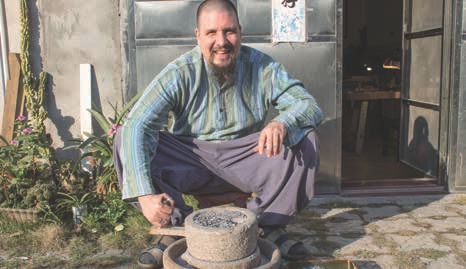
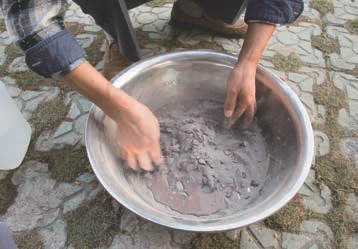


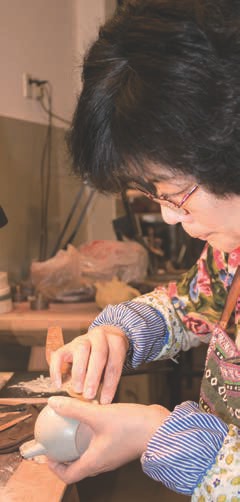
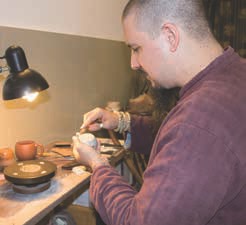

After I choose the white/duanni ore, we spent some time breaking it into pieces with a hammer. We obviously wouldn't have time to go about this in the right way, which would mean weathering the ore outside for months, if not years until it was reduced to small pebbles. After breaking the ore into pebbles, we ground them by hand in an old stone mill that Master Zhou has kept as an heirloom of the olden days. I was pretty good at this, since Master Zhou carving a special inscription on our pot: "In the Teapot City, Wu De, Zhou & Chen hand in hand collaborating." we regularly grind many kinds of tea at the center. The movements were similar, and I quickly got the hang of adding pebbles to the rhythm of the wheel. Like the teas we grind, Master Zhou and I had to grind the ore several times through to get it into a powder, taking a few hours. His students all watched wide-eyed. I was amazed to learn that many of them had never seen this process done in the old way. Master Zhou promised me, though, that he is trying to inspire them to love purple-sand art and heritage, and to love tea brewing as well. He hopes to pass on his wisdom to the next generation. And this was a great opportunity for all of us to learn.
After the ore was ground into a powder, we ran magnets through it to pull out any bits of iron that would make black spots on the fired pot. This process wasn't done long ago, which is one reason old pots often have such iron spots on them (some black spots are due to firing). Then we mixed the powder with good spring water and made clay. The clay is then pounded with a wooden mallet to get out any air bubbles and to thoroughly blend it. At this point, it would be best to age the clay, letting it ferment. Master Zhou separated the clay into two bricks, one for our pot and one for aging, which I would take back to the center with me. Master Zhou said we could make another, similar pot in ten or twenty years and see how they compare. Fun!
After letting the clay sit over night, we got started making our pot. We decided to use a mold, due to time constraints. I had been playing with clay all week, not with the intention of finishing anything, but rather just to see exactly how hard it was to make a pot from scratch. Even with lots of help, I'd hardly finished the body after hours and hours of straining. It is much harder than you'd think! We had decided to make one of my favorite teapot shapes: "Wagon's Wheel (ju lun zhu, 巨輪珠)", named for its large, flat button. Many of these pots were exported to Japan, where they were treasured and preserved well. This means that most of them are around nowadays, as opposed to Chinese antiques, which were ill-treated, especially during the Cultural Revolution. Also, the simple design and cannon spout make them appealing to gongfu practitioners. Even getting the clay properly into the body, spout and lid molds is difficult. After letting the clay sit for a while in the molds, we spent a bit of time here and there finishing the pot over the next two days. Master Zhou, his amazing wife Master Chen and I worked on it together. They helped guide me through attaching the pieces and then aligning and finishing them. Steps that these masters could do in minutes took me hours, but they were patient and kind as in all matters. Eventually we finished our glorious pot.

As we fired the pot for eighteen hours, I was left humbled by the amount of devotion that goes into this craft. I have fallen in love again. I feel like someone whose marriage has been given a renewed boost of passion. An amazing amount of knowledge, skill, culture, heritage and history surrounds these amazing pots. Master Zhou so wisely articulated that all of that work culminates in a fine cup of tea, which then becomes us. "A love for Tea inspired this centuries-long journey!" he exclaimed. With moist eyes, I reminded Master Chen and Master Zhou that their pots are in my life every day, which means that they are with me all the time - in all the tea I share. And after their amazing hospitality, and all that I had learned and experienced, those pots would never be the same again... Sure enough, when I got back to the center, one of my favorite pots - a piece by Master Chen - glowed like never before, beckoning me to brew some Cliff Tea. As I sat down to drink, the pot connected to my hand better than before. And I knew that it was my hand that had changed...

Antique pots make better tea for four main reasons. The first one is discussed in the article: they were made to brew tea. There were more functional pots back in the day, before the growing trend of making objects of art which began in the late Qing Dynasty. Secondly, the men who made pots long ago lived in a different time. In those days, a teapot maker would do nothing else in life. As a young child, he would sweep up in the studio. Later, he'd learn about the ore and clay, before going on to make his first pot - probably in his teenage years. He would never study anything else. His whole life would be devoted to teapots. Furthermore, he would eat only organic vegetables, etc. And his mind wasn't distracted by computers or cell phones. Teapots were everything to him. The third reason is that the effort and patience, as well as the tools used to refine the ore, make clay, build the pots and fire them all required many different people with specialized skills - much of which has been lost today. In those days, there were master miners, ore evaluators, clay makers and kiln masters. Finally, there is something to the age of the pots. This has to do with the energy of the Five Elements. In Tea, the teaware is the Earth energy. When it is fired, however, a pot turns into Fire. All the particles erupt in heat, whizzing around at great velocities. Therefore, the further in time we get from the firing, the more the energetic structure of the pot returns to Earth - reorganizing itself to be as it was when it was ore deep in the ground.